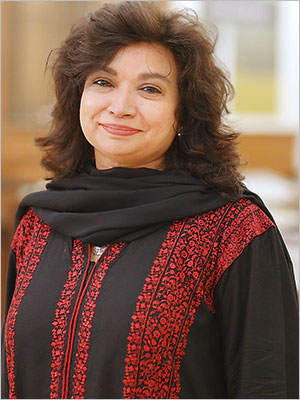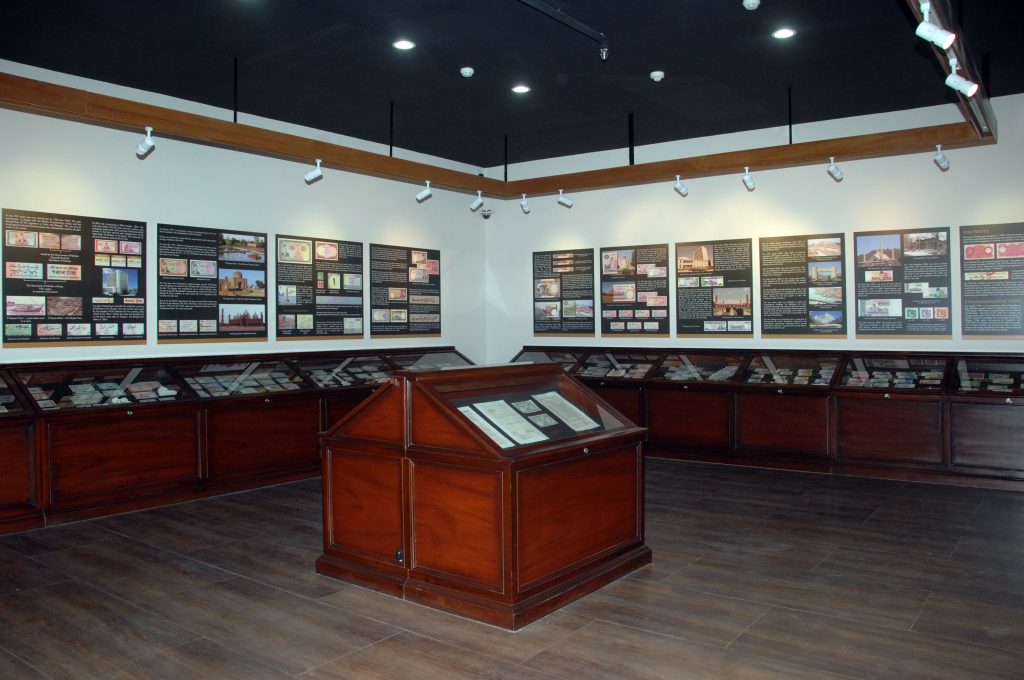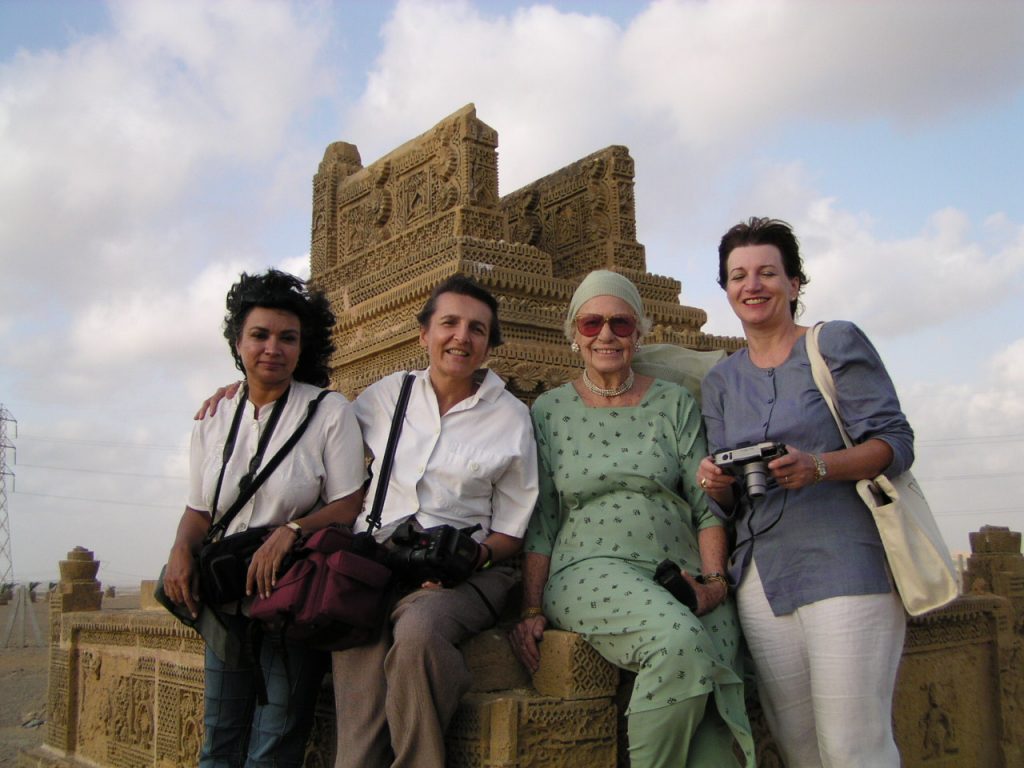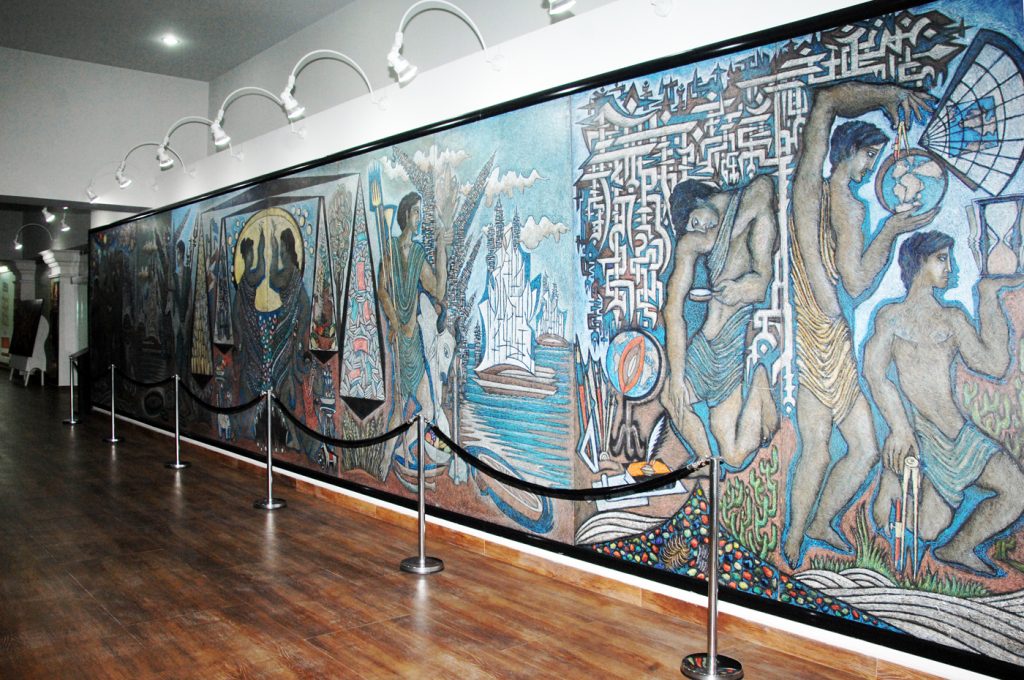Interview: Dr. Asma Ibrahim
By Deneb Sumbul | Interview | Published 7 years ago
“I had to sacrifice a lot as a woman in order to remain in this field.”
A n archaeologist and a museulogist by profession, Dr. Asma Ibrahim, Director of the Museum and Art Gallery Department, State Bank of Pakistan (SBP), is also otherwise known as “Madam Museum” — and with good reason.
n archaeologist and a museulogist by profession, Dr. Asma Ibrahim, Director of the Museum and Art Gallery Department, State Bank of Pakistan (SBP), is also otherwise known as “Madam Museum” — and with good reason.
As a student, her interest in the subject of human evolution led her on a long, adventurous, and sometimes arduous journey. After acquiring a Masters degree in History (Archaeology), Ibrahim joined the Department of Archaeology & Museums as Assistant Curator. Additionally, she wrote for several publications and a few Social Studies course books for children. In 1990, she was appointed Assistant Director, Department of Archaeology and Museums, Government of Pakistan, and served in that position for 16 years — without a single promotion. Alongside, she continued with her studies and acquired a PhD in Numismatics. The subject of her thesis was Indo-Greek coins in Sindh and Balochistan. She followed it up with a Fulbright Post-Doctorate fellowship in ‘Ancient Human Remains.’ And also a two-year course in anatomy from the Aga Khan University and Hospital.
She joined the SBP in 2006 and was assigned the task of establishing Pakistan’s first state-of-the-art Monetary Museum and setting up an art gallery and the department of Museum and Art Gallery. The Museum was the first to become a member of the International Council of Museums (ICOM) and the Commonwealth Association of Museums (CAM).
Ibrahim has been part of innumerable exploratory and excavation trips and has worked with German and French archaeological missions. Some of the other museums she has helped establish are the Oxford University Press Museum, the Sindh Police Museum and the Mukhi House Museum of Recent Past. As a student of several languages, she is adept in three ancient ones — Brahmi, Kharoshti and Cuneiform script — all vital to her work.
Along with a fellow archaeologist she established a Centre for Archaeological & Environmental Research in 2000, which has a Conservation Lab, a library, a documentation centre and holds trainings in the dying arts and crafts of Pakistan.
Dr. Asma Ibrahim became the custodian of the infamous mummy discovered in Balochistan in 2000, that had made headlines in the international media. It became the subject of the BBC Horizons’ documentary, `The Mystery of the Persian Mummy,’ in which she, as the curator, and the mummy, were the central characters. It documented over a year the investigation behind the strange Iranian mummy, that was claimed to be of an ancient Persian princess, over 2,600 years old, wearing an exquisite golden crown and mask, encased in a carved stone coffin placed inside a wooden sarcophagus.
What drew you to the subject of archaeology and what difficulties did you face as a female archaeologist?
It was my curiosity in human evolution that led me to pursue my interest in archaeology. I joined the Karachi University, which unfortunately does not have a separate department of archaeology even now, but the subject is taught under General History.
There were 10 of us in the batch and only the boys were taken on excavations; the girls were sent to the National Museum, which really agitated me. After completing my Masters, I went on a job hunt; wrote children’s course books for the Far Eastern Company publishing house but never forgot my first passion. I approached the Department of Archaeology with my gold medallist credentials — but I came in for a rude shock when I was told their department didn’t appoint girls. But when the Public Service Commission announced job openings, I was selected on merit. At the time, archaeology was a federal subject department but after devolution in 2011, it became a provincial subject.
During my tenure at the Archaeology Department in the 1990s, I was posted in their Exploration and Excavation branch on Shahra-e-Faisal, where I met with another setback. They informed me that I could not go on excavations. It felt more like a punishment because there was no other female staff; moreover, the place seemed more like a dungeon.
I was permitted to go on my first excavation at the end of 1990, only after I submitted a letter saying I would personally be responsible for any loss or damage I suffered on the trip. Eventually my dream came true and I went on an exploration mission to Ratto Kot island with a female representative from the French Archaeological Mission working in Sindh. The Ratto Kot Island is around the Korangi Creek vicinity of the Indus Delta and it was one of my toughest explorations. The Ratto Kot fortress dates back to the Sassanian era (the last Iranian empire before the rise of Islam in the 4th century A.D.) and is a contemporary of the Debal [Karachi] port). We would start the journey from my house at 4 am and travel to Ibrahim Hyderi. From there it was a four-hour boat ride to the island and another hour’s walk to reach the ruins of a small ancient fort made of red bricks. We did this every single day for a month.
I had to sacrifice a lot as a woman in order to remain in this field. My initial years were torturous, because the department didn’t approve of me. I remained in the same grade in my 16 years as a curator (1990-2006) at the National Museum of Pakistan.
But despite the discrimination, I continued to work there out of my passion for archaeology. You cannot imagine the kind of character-assassination I was subjected to, especially when I accompanied any foreigner to the archaeological sites. Consequently, in all these years, I have not been able to convince another girl to come and work in the field.
In 2006 I got a job with the State Bank of Pakistan to establish Pakistan’s first Numismatics Museum. The task was multifaceted. I began with the conservation of a 1920’s building that was constructed for the Imperial Bank of India by the British government. Later, I got to work on the acquisition of the collection for display and the recruitment and training of staff and other related works. Being on the board of several educational institutions and the Karachi Conference Foundation, I continue to give lectures on my related fields.
Is it usual for state banks around the world to establish coin museums?
Yes, most central banks around the world do have such museums and that’s what the then State Bank Governor, Dr. Ishrat Hussain, wanted. It was his idea and he dedicated this building for its establishment. It took me from 2006 to 2011 to set it up. The museum traces the monetary history of this part of our world from 600 BC to 2014 and the unique aspect is that not a single year is missing. There are stamps, currencies and currency printing plates as well in the collection.
We also have a beautiful art gallery of works by Sadequain and a mural by Zahoor-ul-Akhlaq and a contemporary art gallery which sponsors young and unknown artists. I designed the museum in a way that people would find it interesting and keep coming, otherwise who would want to come just to see a small monetary museum — it could be very boring. Also it is the only museum accessible by wheelchair; additionally, it is designed for the deaf mute, as well as the blind. I tried to make it as interactive as possible. We have a website, a Facebook page and a Twitter account too.
What did it take to set up the Numismatics Museum?
I set it up from scratch. I took 10 fresh graduates from Karachi University’s (KU) Department of Visual Studies and a few others and trained them in different aspects, such as digitisation, deciphering coins, conservation of metal coins, model-making, museum graphics — all of which we don’t have in Pakistan. They all helped me establish this museum. We have in the museum a very nice souvenir shop, where replicas and models of the artefacts are on sale.
The coins have all been purchased from private collectors, whom I got to know while working in the National Museum. Since my PhD is in Numismatics, I can discern the fake ones. We go for a lab test only when we are uncertain about the times they date back to. There are two ways of dating — one is relative and the other scientific. We first do relative dating, in which we examine the art patterns, the writing and the metal. When we are not satisfied, we opt for the expensive process of scientific analysis. But usually, we can identify a coin immediately by touch, since we do it so regularly.
I have digitised the collections in the galleries in this museum to make them more interactive and put up kiosks, especially for the children. We also have a mini-theatre where we show movies to demonstrate how coins are made. I have put a lot of emphasis on visuals in all the museums I have worked in, because people don’t take the time to read and want the information very quickly. Take the example of Facebook — people share articles without reading them fully. I hold summer camps here for children as young as three because that’s the age they start observing. We have about 300 kids between the ages of 3 to 15 years and conduct different activities such as teaching them the art of calligraphy, traditional arts and crafts. However, this is not open to the public; these are children of the employees of the State Bank and the museum.
However, the museum is open and free for the public; schoolchildren come here quite often and we often hold talks for them or show them a movie if that’s what they want; then they can paint or go on treasure hunts.
Since there is no Archaeology Department at the Karachi University, where do students with an interest in the subject go?
Students seldom approach the subject because there is hardly any scope in it. Second year students in General History at the KU have to choose between International Relations, European History and Archaeology and due to the lack of job opportunities in this field, they usually go for International Relations because they can usually find related jobs. Students can do their PhD with the General History Department.
For the last five years I am heading the Pakistan Archaeology Mission (Government of Sindh, Department of Antiquities) for the French-Italian-Pakistani Mission that is carrying out excavations in Bhambore. The State Bank allows me to go on two to three months leave for this purpose. A lot of young officers from the Departments of Antiquity and Culture join us for the practical experience.
I bring this up at every forum, at every conference, in front of ministers, that we need to establish a separate, full-fledged Department of Archaeology at the KU, with teachers running a two-year course in archaeology. It will open up several avenues for students, some who whom would return with PhDs to teach or work. It is all inter-related — if you don’t create job markets for the students, why would they come into this field — and who then, will look after our entire heritage in Sindh?
There are thousands of historical sites in Sindh that are in a total state of deterioration because there is no department of conservation. What’s more, there are no specialists to teach students how to conserve their heritage.
What is the state of Pakistan’s heritage sites generally — and what are the greatest risks to them?
Let’s start with our World Heritage sites in Makli and Moenjo Daro in Sindh. In a BBC interview I was asked, “Till when do you think the Moenjo Daro site will survive?” Looking at the present state of Moenjo Daro and its management and preservation, I don’t think it will last more than 20 years. Water-logging and salinity pose a grave threat to the foundation of the city and its walls will soon crumble down. The site needs a conservation master plan. The same goes for Makli. Both Mohenjo Daro and Makli are the most valuable heritage sites we have, not only in Sindh, but in the world. For the last several years I have not seen the government spend any funds on their preservation in a proper scientific manner.
Is it due to budget constraints?
There is an annual budget earmarked for restoration and conservation, but there is hardly any visible change or improvement at these sites. In 2011, after devolution, 130 archaeological sites including Moenjo Daro, the Makli necropolis, Rani Kot, Umerkot, Bhambore near Thatta and Kot Diji in Khairpur were transferred from the federal to the Sindh government, along with the museums.
It was a mistake in the sense that they were handed over without providing the department with the necessary manpower or trained personnel. These sites were simply handed over to the Sindh government, who didn’t have a single archaeologist in Sindh’s Department of Antiquity — incidentally, there isn’t one even now.
Before devolution, these sites were still looked after by the central government, which had a few conservationists [on the staff] but gradually they retired and there are no plans for any replacements.
Another thing that did a lot of damage was the recruitment ban on government positions — the first thing every government does when they come to power. The department couldn’t recruit people for a long time; as a result there is a complete vacuum. When senior experts retired, there were no trained specialists to replace them.
To save the country’s heritage, the basic infrastructure for archaeology needs to be revised, with revised pay scales, designations and posts. It makes me sick to see how all this precious legacy is just slipping away from our hands.
Do we have a scientific lab for this purpose in Pakistan?
No. We are the walking lab. A lot of paintings come to us for authentication. Several fake Sadequains are floating in the market and someone in authority, for a fee, is claiming they are real when actually they are not. People who bring those paintings to me for verification insist that a notable person has authenticated them. I tell them that I can prove that they are fake.
Forged Sadequain paintings are very easy to identify because he had a unique style and his strokes are very hard to imitate. While establishing the art gallery at the State Bank Museum, I became an authority on them because I went through so many. Mostly Sadeqain did not sign his paintings. He didn’t even sign the murals that he painted here — except for the last one. People even treat the canvases to make them look old — they have become such experts in making fakes. Gandhara artefacts are even harder to distinguish, even by seasoned experts.
Once a Buddha head was sent to me for authentication because they [government] wanted to gift it to a head of state. When I told them it was fake, they were quite shocked.
Are you allowed to give national treasures and antiquities as gifts to foreign heads of states?
Yes, as a diplomatic gesture, but they eventually come back. Before, this would happen quite often; now it is not as frequent, but it still happens.
What is the state of museums around the country?
I think the Khyber Pakhtunkhwa government is picking up after devolution. They are doing a lot of digitisation of the artefacts and making websites. Their Director-General is young and very active and is doing good work. In Punjab, I feel it’s all status quo — no new acquisitions or excavations.
However, a new trend has been witnessed after the launch of the State Bank Museum. Earlier, everybody thought museums were only established by governments. Then people came to know that institutions could also set up museums. Now several institutions have approached me to help them set up their own. I am doing several at the moment. I was consultant for the Oxford Press Museum and Archives, which is about the history of their publications and I also have also helped set up their small archives section; we have completed the Sindh Police Museum, to a large extent.
I am also on the Mukhi House Committee. The Mukhi House in Hyderabad, which comes under the Sindh Government, is a beautiful building constructed with all the trappings of a palace in the 1920s by a prominent Hindu. It was abandoned during Partition — later it was set on fire. The structure has now been completely restored and turned into a cultural museum. In Shikarpur as well as in Khairpur, work is being done to set up city museums. The Sindh government has undertaken a few projects, but they grind to a halt every time a new minister comes in.
Now we have a new minister for Culture in Sindh and things have started to move. There are initiatives like the Sindh Police Museum. The idea has spread and now more is being done by private institutions, like there is a computer museum in the pipeline, and people from the hosiery industry have approached me for a museum of their own and we are in the planning stages.
As people are becoming more aware, they have also started donating to museums. For the State Bank Museum, for instance, people donated many items and still do. A private collector has given paintings of Zahoor-ul-Ikhlaq on loan. Adil Salahuddin, Pakistan’s foremost stamp designer, donated his lifetime collection of stamps, currency notes and printing plates of Pakistan. Mrs. Towfiq Chinoy has donated several folk costumes for display at the Mukhi House.
How rampant is the pilferage of artefacts from museums?
When I was working at the National Museum, there was a curator who used to sell real coins and replace them with less valuable ones. The price of an artefact is based on its rarity. Not all artefacts are necessarily expensive. Out of 10 coins, one may be expensive because it’s rare or belongs to a limited edition. There are many aspects to a coin that only a professional would know. If a curator is dishonest, then anything is possible. We filed a case against the lady and won. She had pilfered some very rare coins from the coin collection at the National Museum which we never got back. I have heard similar stories about the Peshawar and Lahore museums. The Gandhara coins, and also those from Balochistan, are very expensive. Pilferage of artefacts is mostly an inside job.
Recently, a very large consignment of pre-historic Balochistan pottery was being smuggled to Dubai, and was probably caught on its way to the port. Another time, a very large consignment of stolen Gandhara artefacts was caught — it turned out they were mostly fakes.
It is usually very hard to sell an object that has been removed from a museum. There are strict rules in place and there is a number in accession ink on every artefact, which is water-proof and impossible to remove. Also, people avoid buying them. There are registers for all the objects that are regularly verified. But there are museums where relics were just lying around without verification and haven’t been digitised. In such cases there has been a lot of pilferage.
In 2015, the Sindh Archaeology Department shifted a huge amount of precious artefacts — in fact almost the entire collection from the time of Pakistan’s inception — from the exploration branch, a rented place on Shahra-e-Faisal, to the National Museum in the most unprofessional manner. Whenever antiquities are discovered from a site, they are sent to the exploration branch. The team there studies and publishes their findings and only after that can they be distributed to the different museums of Pakistan. It was a big treasure.
In this particular instance, they wrapped these priceless items in newspapers, packed them in cartons of juice boxes and dumped them in the National Museum. These include invaluable artefacts from the Mehrgarh civilisation (Neolithic 7000 BCE to 2500/2000 BCE), the Nindo Wari collection, the Saidu Sharif collection, several other collections and very rare antiquities from all over Pakistan. There were more than 150,000 antiquities, including 3,000 figurines belonging to the BC period. I don’t know what state they are in now or how they are protected. It was covered by the local channels and even the BBC, but to no avail.
I wrote to the Heritage Committee but nothing happened except that they were put in wooden almirahs. No antiquity can be moved without a proforma, photographs and a detailed condition report. Many of the artefacts are delicate and require special boxes and need to be packaged in special wrapping material using specific techniques. The culture minister was supposed to be its custodian. Even our archaeological library, which has some of the rarest books in archaeology, has been packed up in those cartons. In the 1990s there was a plan to ship this library to Lahore but we appealed to the High Court and prevented it from being taken to the Punjab.
It was on the orders of the Sindh Minister for Culture at the time that this invaluable treasure trove was moved so sloppily from the Exploration and Excavation Branch, where it lay safe for years. Antiquities have to be catalogued in the registers and logged the moment they are moved, but these weren’t. If one of the figurines, which is very expensive, goes missing, how will one check as to which one has disappeared? Even after alerting the press, including the BBC, the government didn’t move; the then chief minister didn’t do anything either. We don’t know how much of our heritage has gotten damaged in the process.
The archaeological community and I had objected to the Sindh Cultural Event that was organised at Moenjo Daro in 2014. I had requested the organisers to follow the UNESCO Heritage Rules, i.e. all activities should be kept away at least 200 feet from the heritage site but to no avail. Not only did they hold the event, we were threatened not to speak about it.
Since you have worked around the Delta area, how many undiscovered sites, in your estimate, still remain above and under water?
Working around the Indus Delta for the last 15 years I had plans to establish a department of underwater archaeology, which sadly didn’t materialise. The delta changes its course every 60 years, so there may be many forts that get submerged during high tide, like Ratto Kot and Juna Shah Bunder, where we have also worked. While documenting all the sites, I discovered some underwater including one dating back to the 12th century AD not mentioned in any historical source. I have published my work on it.
I suspect there are lots of sites along the delta and the Sindh coastline, as a lot of archaeological work is being done in India in this regard. I feel there may be some prehistoric sites that traded with Oman and India during the time of the Indus Valley civilisation. Even one survey would reveal a lot. Take Balochistan — every few kilometers you will find a pre-historic site. It is a hugely rich, undiscovered area — beyond one’s imagination!
The writer is working with the Newsline as Assistant Editor, she is a documentary filmmaker and activist.




